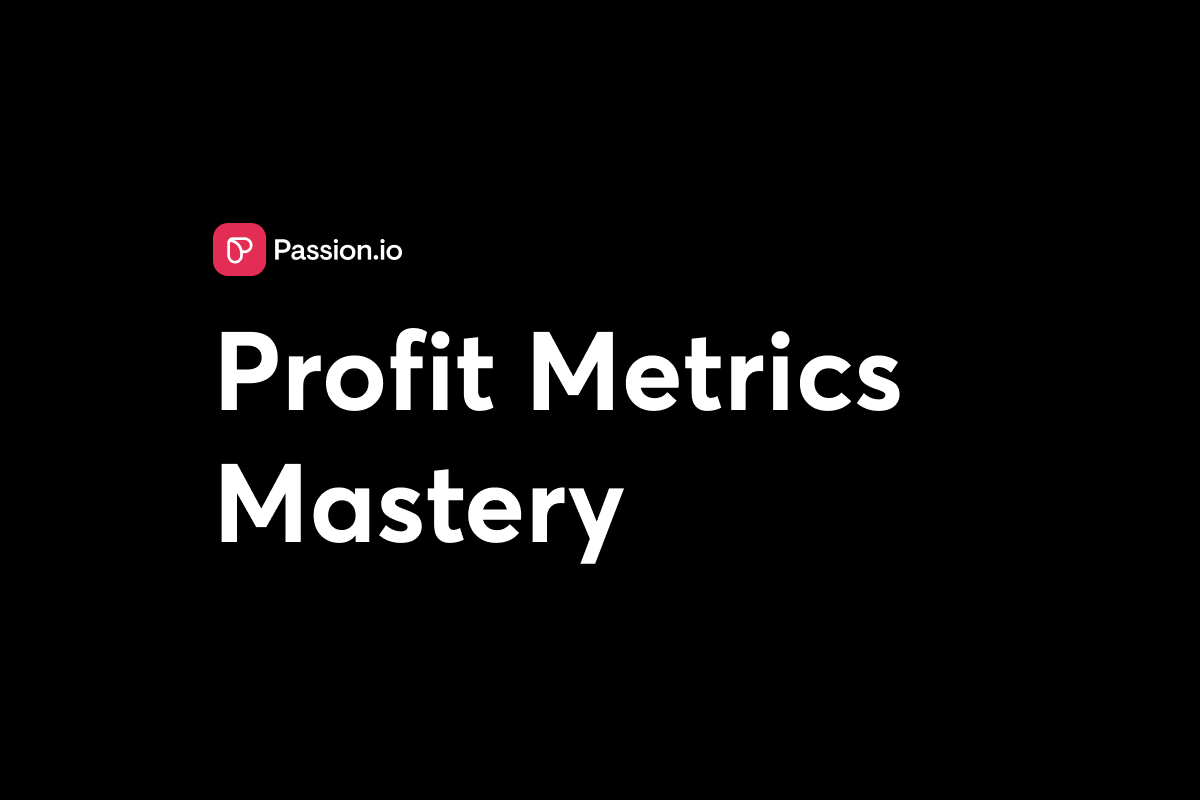Updated 30th October, 2025
If you sell memberships, courses, or coaching through a branded app, profitability hinges on four numbers: LTV, CAC, LTV/CAC, and CAC payback. This guide shows you how to calculate each with simple formulas, creator-specific examples, and how to include platform fees like PassionPayments and Apple or Google in-app purchases.
Why LTV, CAC, and payback drive creator success
Launch spikes are exciting, but sustainable growth comes from predictable retention, recurring revenue, and disciplined acquisition. LTV tells you how much a typical customer is worth, while CAC reveals the cost to acquire them. Operators often target an LTV/CAC near 3:1 and CAC payback within 12 months so cash does not get trapped in acquisition.
Creators on Passion get mobile-first engagement levers like push notifications and in-app community that lift completion and renewals, which directly improves LTV. See the app builder features.
"What I love about Passion is that it's not just a platform to create your own app - it also provides invaluable training on how to build and sell your course." — Mathilde N. on G2
What are LTV, CAC, LTV/CAC ratio, and CAC payback period?
- Customer lifetime value (LTV). The total gross profit you expect from one customer over their active relationship. A common subscription formula is LTV = ARPU x gross margin ÷ monthly churn. See the LTV explainer from Wall Street Prep.
- Customer acquisition cost (CAC). Total sales and marketing costs divided by the number of new paying customers acquired in the same period.
- LTV/CAC ratio. LTV divided by CAC. Around 3:1 is a common target for healthy growth, while far above 3:1 can mean you are under-investing in growth. See Chargebee's LTV/CAC guide.
- CAC payback period. Months required to recover CAC from monthly gross profit per customer. Payback = CAC ÷ (monthly ARPU x gross margin). Many operators aim under 12 months. Geckoboard's payback guide covers the basics.
How to calculate customer lifetime value (LTV) for your creator business
Start simple. Then refine with your margins and offer mix.
Simple LTV calculation for subscription apps
- Pick a period. Use monthly numbers for ARPU and churn.
- Compute ARPU. Average monthly revenue per active subscriber.
- Estimate gross margin. Subtract direct delivery costs like video hosting, support time, and payment fees.
- Measure monthly churn. Customers lost this month ÷ customers at start of month.
- Calculate LTV: LTV = ARPU x gross margin ÷ churn.
Example for a fitness app
- Monthly price: $29
- Gross margin: 70%
- Monthly churn: 5%
- LTV = $29 x 0.70 ÷ 0.05 = $406
Adjust ARPU or margin to match where your audience buys.
Margin-adjusted LTV for online courses
For one-time courses without a subscription, use a margin-adjusted model.
- Average order value across 12 months.
- Purchase frequency in that window.
- Gross margin for delivery.
- Expected active lifespan for follow-on purchases.
LTV = AOV x purchase frequency x gross margin x customer lifespan. This captures bundles and repeat buys. Shift to the subscription formula for any membership lines you add.
Factoring in diverse revenue streams (subscriptions, one-time, bundles)
Many businesses sell a monthly membership plus one-time intensives and higher-price bundles.
- Compute LTV by product line.
- Weight fees by channel mix. Example: 70% web at 3.9%, 30% IAP at 15-30%.
- Sum product-line LTVs for a blended LTV per customer.
- Revisit quarterly as your mix shifts.
How to calculate your customer acquisition cost (CAC)
CAC covers every dollar spent to acquire paying customers in a defined period.
Include ad spend, creator fees, agency retainers, sales and marketing salaries, software, creative, and promos.
Exclude delivery costs after purchase. Use paying customers only in the denominator.
CAC = total acquisition spend ÷ number of new paying customers in the same period.
Including marketing spend and platform fees
- Platform fees are not CAC. They reduce revenue and belong in gross margin for LTV.
- Typical fees to model in margin: PassionPayments 3.9% for web, Apple/Google IAP 15-30% for in-app purchases.
- Budget for developer accounts as fixed launch costs: Apple $99/year, Google Play $25 one-time.
What does your LTV/CAC ratio tell you about profitability?
LTV/CAC = LTV ÷ CAC
- Near 3:1 usually indicates a healthy path to scale.
- Under 1:1 means you lose money per customer and need to raise price, cut CAC, or improve retention.
- Far above 3:1 suggests room to invest more in acquisition while staying profitable.
Use this ratio with CAC payback to make month-to-month budget calls.
How long until you recover acquisition costs? (CAC payback period)
Payback shows how fast cash returns so you can reinvest.
Formula: payback months = CAC ÷ (monthly ARPU x gross margin). Targets under 12 months are common, with 5-7 months seen as strong.
Calculating payback for apps and courses
Example
- CAC: $120
- Monthly ARPU: $25
- Gross margin: 70%
- Payback = $120 ÷ ($25 x 0.70) = 6.86 months
If payback climbs above 12 months, adjust pricing, packaging, or channels to improve ARPU, margin, or CAC.
Actionable strategies to optimize LTV/CAC and reduce payback
Small levers compound. Focus on retention, ARPU, and acquisition efficiency.
Boost retention with in-app engagement
- Onboard with a 7-day quick-win path.
- Schedule weekly push notifications for checkpoints and wins.
- Host a community channel for accountability and Q&A.
- Run 30-day challenges with badges and progress tracking.
Real words from a Passion user:
"They lay it out clearly and are available for support. The platform is easy to use with clear directions on what to do next. The number of features available are amazing, right down to tracking integrations built right in." — Michele D. P. on G2
Increase average revenue per user (ARPU)
- Offer annual plans at a 2-month discount.
- Add bundles that include community and office hours.
- Use upsells after lesson milestones.
- Route high-ticket bundles to web checkout to avoid 15-30% IAP tolls when possible. PassionPayments uses a 3.9% platform fee for web.
Improve acquisition efficiency
- Double down on channels with lowest CAC and fastest payback.
- Add referral boosts inside your app after lesson completion.
- Standardize creative for your top three audiences and iterate weekly.
- Track CAC by channel and cohort to spot churn risk early.
Tools and calculators for tracking your key metrics
- Free LTV/CAC Excel template. Run your numbers in under an hour.
- Platform analytics. Track revenue, subscriptions, and member activity so you can measure LTV drivers like completion and DAU/MAU.
- For a step-by-step walkthrough, watch Passion.io Tutorial 2025 on YouTube.
- Training and playbooks. Read recent customer feedback to see how creators use the platform.
"Passion makes building your own e-learning app fast, simple, and stress-free. With their no-code, drag-and-drop platform, I was able to design, build, and launch a fully functional app in just a few hours-no tech experience required." — Rob M. on G2
"I am so grateful for my Passion App! The building app education is clear, step by step, pedagogical guidance in a nudging way with a humorous touch - love it! It is easy to build with this guidance and the support team is just fabulous, every step of the way!" — Åsa Lindstedt on Trustpilot
LTV calculation methods comparison
Worked example: subscription app and course bundle
- Price mix: 70% subscribers at 29/month, 30% one-time course buyers at 99 average.
- Channel mix: 60% buy on web checkout, 40% via IAP.
- Fees: Web checkout platform fee 3.9%, IAP 15% small business tier.
- Gross delivery costs: 8% of revenue.
- Monthly churn: 4%.
- CAC: $110.
Step 1. Net subscription ARPU
- Web net per month: $29 x (1 - 0.039) = $27.87.
- IAP net per month: $29 x (1 - 0.15) = $24.65.
- Blended ARPU: 0.6 x $27.87 + 0.4 x $24.65 = $26.78.
Step 2. Gross margin
- Delivery cost 8%. Net margin percent = 92%.
- LTV = $26.78 x 0.92 ÷ 0.04 = $615.
Step 3. LTV/CAC and payback
- LTV/CAC = $615 ÷ $110 = 5.6:1.
- Payback = $110 ÷ ($26.78 x 0.92) = 4.4 months.
Result: Healthy ratio with sub-6-month payback. Room to scale ads while protecting margin.
Tip: Route higher-price bundles to web checkout to avoid 15-30% IAP tolls and protect ARPU.
Grow profitably with Passion
Run your numbers using the free LTV/CAC calculator template and see how a branded mobile app with push notifications and community features can boost course completion and renewals. Explore app monetization features and get started risk-free with Passion’s 30-day money-back guarantee.
Key terminology glossary
- Customer lifetime value (LTV): Total gross profit expected from a customer.
- Customer acquisition cost (CAC): Sales and marketing cost per new paying customer.
- LTV/CAC ratio: LTV divided by CAC.
- CAC payback period: Months to recover CAC from monthly gross profit.
- ARPU: Average revenue per user per month.
- Churn rate: Percent of customers who cancel in a period.
- Gross margin: Percent of revenue remaining after direct delivery costs.
- In-app purchases (IAP): Purchases inside native apps subject to Apple or Google fees.
FAQs
What is a good LTV/CAC ratio for a creator app?
Target around 3:1. Much higher can signal under-investment in growth.
What is a healthy CAC payback period?
Under 12 months is a common rule. 5-7 months is considered strong for reinvestment.
Do platform fees go into CAC?
No. Treat PassionPayments and IAP fees as a reduction to revenue in your LTV margin, not as CAC. Include all sales and marketing in CAC.
How often should I recall these metrics?
Monthly for active channels, quarterly at minimum. Keep periods consistent across ARPU, churn, and CAC.
Do I need Apple and Google developer accounts?
Yes. Apple is $99 per year and offers a 15% program for eligible developers. Google Play is $25 one-time.
Where can I see real creator results?
Browse cross-niche wins in the creator case studies.
How should I choose between web checkout and IAP?
Use IAP for convenience and low-ticket offers. Use web checkout for high-ticket to protect margin. SplitMetrics summarizes typical Apple and Google fee structures.
Where can I watch a walkthrough or hear from customers?
Watch success stories in this YouTube review roundup, 3 Passion.io app examples and success stories.














